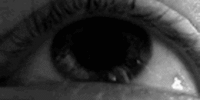Vibrating vision: Difference between revisions
>Josikins m Text replacement - "Category:Psychoactive substances" to "Category:Psychoactive substance" |
>Josikins changing effect categories |
||
| (44 intermediate revisions by 3 users not shown) | |||
| Line 1: | Line 1: | ||
<onlyinclude> | <onlyinclude> | ||
[[File: | [[File:Vibrating vision 2.gif|200px|thumb|right|Involuntary eye movements]] | ||
'''Vibrating vision''' | '''Vibrating vision''', also known as '''nystagmus''', can be described as the experience of constant, rapid involuntary eye movements in which the eyes shift from left to right in such quick succession that the person's vision begins to vibrate and blur. This can severely impair vision and result in a reduced ability to function and perform basic tasks which necessitate the use of sight. | ||
Vibrating vision is often accompanied and enhanced by other coinciding effects such as [[stimulation]] and [[thought acceleration]]. It is most commonly induced under the influence of [[dosage#heavy|heavy]] [[dosage|dosages]] of [[stimulant]] compounds, such as [[MDMA]], [[amphetamine]], and [[4-FA]]. | |||
</onlyinclude> | </onlyinclude> | ||
===Psychoactive substances=== | ===Psychoactive substances=== | ||
Compounds within our [[psychoactive substance index]] which may cause this effect include: | Compounds within our [[psychoactive substance index]] which may cause this effect include: | ||
{{#ask:[[Category:Psychoactive substance]][[Effect::Vibrating vision]]|format=ul|Columns= | {{#ask:[[Category:Psychoactive substance]][[Effect::Vibrating vision]]|format=ul|Columns=2}} | ||
===Experience reports=== | ===Experience reports=== | ||
Anecdotal reports which describe this effect within our [[experience index]] include: | Anecdotal reports which describe this effect within our [[experience index]] include: | ||
{{#ask:[[Category:Experience]][[Effect::Vibrating vision]]|format=ul|Columns=1}} | {{#ask:[[Category:Experience]][[Effect::Vibrating vision]]|format=ul|Columns=1}} | ||
===See also=== | ===See also=== | ||
*[[Responsible use]] | |||
*[[Subjective effects index]] | *[[Subjective effects index]] | ||
*[[Stimulants]] | *[[Stimulants]] | ||
| Line 15: | Line 18: | ||
*[[Deliriants#Subjective_effects|Deliriants - Subjective effects]] | *[[Deliriants#Subjective_effects|Deliriants - Subjective effects]] | ||
*[[Psychedelics#Subjective_effects|Psychedelics - Subjective effects]] | *[[Psychedelics#Subjective_effects|Psychedelics - Subjective effects]] | ||
[[Category: | ===External links=== | ||
* [https://en.wikipedia.org/wiki/Nystagmus Nystagmus (Wikipedia)] | |||
[[Category:Physical]] [[Category:Uncomfortable]] [[Category:Bodily]] [[Category:Effect]] | |||
Latest revision as of 20:27, 15 April 2018

Vibrating vision, also known as nystagmus, can be described as the experience of constant, rapid involuntary eye movements in which the eyes shift from left to right in such quick succession that the person's vision begins to vibrate and blur. This can severely impair vision and result in a reduced ability to function and perform basic tasks which necessitate the use of sight.
Vibrating vision is often accompanied and enhanced by other coinciding effects such as stimulation and thought acceleration. It is most commonly induced under the influence of heavy dosages of stimulant compounds, such as MDMA, amphetamine, and 4-FA.
Psychoactive substances
Compounds within our psychoactive substance index which may cause this effect include:
- 3-MMC
- 3-MeO-PCP
- 4-FA
- 4-FMA
- 5-MAPB
- 6-APB
- 6-APDB
- A-PHP
- A-PVP
- Benzydamine
- Butylone
- Datura
- Dextromethorphan
- Ethylone
- Harmala alkaloid
- Kava
- MDA
- MDAI
- MDEA
- MDMA
- MET
- Mephedrone
- Methylone
- Mexedrone
- PMA
- PMMA
Experience reports
Anecdotal reports which describe this effect within our experience index include:
- Experience:150mg MDMA + 20mg 2C-B - I designed it this way myself
- Experience:225mg Pregabalin +Cannabis -Bliss and Serenity; a hedonistic evening
- Experience:30mg (smoked) DMT - The Monolith
- Experience:30mg - Psychostimulant egodeath
- Experience:~150mg MDA(oral) - a case of mistaken identity
See also
- Responsible use
- Subjective effects index
- Stimulants
- Dissociatives - Subjective effects
- Deliriants - Subjective effects
- Psychedelics - Subjective effects